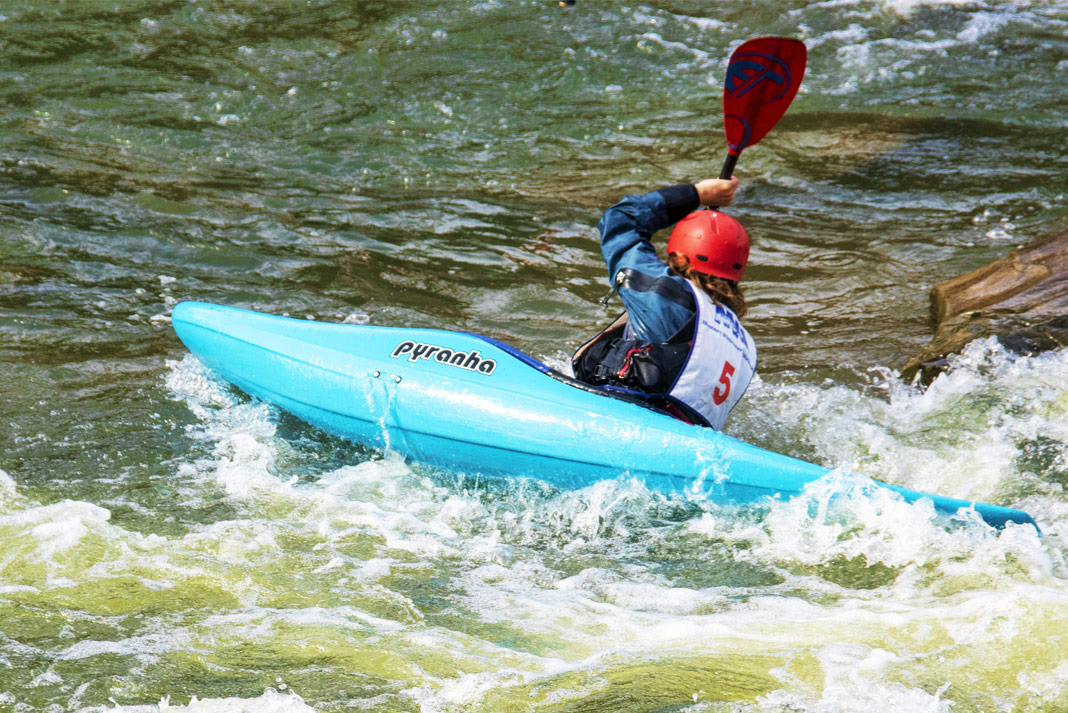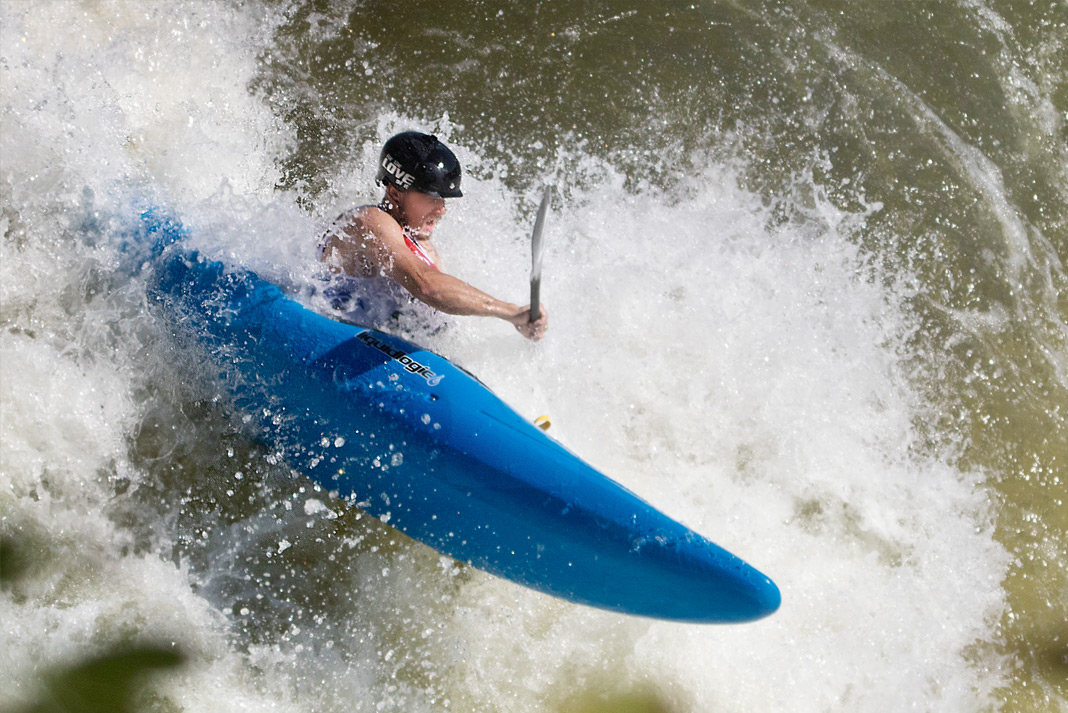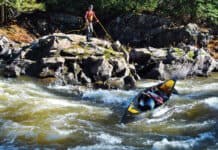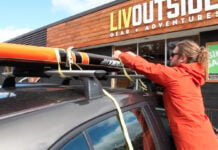Every whitewater kayak has edges of some sort. Some of them are so pronounced that you can reach your hands under your kayak and feel big grooves running parallel along the length of the hull. Some kayaks have less aggressive edges. These edges will feel like rounded corners on the hull of your kayak, and are sometimes so round that the kayak feels like it has no edges at all. However, if used correctly, even these round-bottom kayaks can be paddled on edge.
The purpose of edges on a whitewater kayak is to provide the boat with a flat, stable hull to surf waves and glide across the water on. Edges are responsible for making whitewater kayaks maneuverable and easy to turn in whitewater, as well as making it possible to go in and out of different river currents without capsizing.

How to edge a kayak
Edging a kayak is actually quite easy in flatwater. In order to engage the right edge of your kayak, lift your left knee. In order to engage your left edge, lift your right knee. The part where edging becomes difficult, is when you combine it with moving water and whitewater. For this reason, it is important to practice edging in flatwater before you take it to the river.
Flatwater exercises and drills for practicing edging
When sitting in a kayak, there are several exercises you can do to practice edging.
Strengthening your obliques and hip flexors
For the first edging drill, sit straight upright in your kayak, as if you have a string coming through the top of your head and holding your body in good posture. Have a friend randomly call out “Right,” “Left,” or “Go.” When your friend calls “Go,” lift one knee at a time repeatedly and at a fast pace, so you are rocking back and forth from one edge to another.
As soon as your friend calls “Right,” you stop on your right edge, tightening your left oblique muscles in order to keep your kayak on edge as much as possible. When your friend says “Left,” you do the same thing on your left side. Have your friend call out these commands, one at a time, with several seconds in between them, for about a minute. Take a rest and note how tired your obliques and hip flexors are, then repeat the exercise again.
Increasing awareness of different levels of edge
The second edging drill is less focused on building strength in your obliques, and more focused on creating awareness and stability around the edges of your kayak. This drill exposes the kayaker to the four different “levels” of edge. When paddling different difficulties of whitewater, you will use different levels of edge—lower levels for easier whitewater, and higher levels for more challenging whitewater,
- Level 0: Sitting upright with good posture. The boat is flat, and your knees are both relaxed.
- Level 1: Lift your left butt cheek, as if you are sneakily trying to let out a fart.
- Level 2: Combine level 1 with bringing your rib cage over to the right side of the kayak. Lean your torso a bit.
- Level 3: Combine level 2 with engaging your left knee and lifting it up. You should be fully on edge at this point.
- Level 4: As far as you can get on your right edge without flipping over.
This drill is effective in teaching a kayaker how to control their edges, and how to maneuver their body in a way that allows for the most efficient edging techniques. Practice holding each level of edge for 20 seconds, then switch sides and do the same thing with the other edge.
Eddy turns
Learning how to maneuver a kayak in whitewater can be daunting, but if you know how to edge your kayak properly, the task becomes effortless. An eddy turn is used when you paddle into an eddy or out of an eddy and into the main current. Eddy turns are tricky because the oncoming current you are paddling into has the possibility of grabbing your edge and capsizing you.
The key with eddy turns is to edge your kayak away from the oncoming current. If you are leaving an eddy stationed on the left side of the river and paddling into the main current to head downstream, you will want to lift your right knee, sit on your left edge, and lean away from the oncoming current.
A good way of remembering what to do when edging for eddy turns is to think of the phrase “fart upstream.” If you pretend you are letting out a toot toward the oncoming water, you will lift the correct edge and hopefully avoid capsizing.
Surfing a kayak
Just like edging a surfboard to surf an ocean wave, you must edge your whitewater kayak in order to surf a river wave in your kayak.
If you want to carve to the right, dig your right edge into the wave. If you want to carve to the left, dig your left edge into the wave. Keep edging back and forth, placing rudder strokes as you do this, and you will be surfing away!

Boofing
A boof is a kayaking stroke used to keep the bow of the kayak up while kayaking over a large hydraulic (often called a “hole”) in the river. A boof stroke is placed at the edge of a drop, waterfall or just before a hole. The kayaker positions their body forward, puts their kayak on edge, plants the stroke, thrusts their hips forward, then leans forward again and flattens the boat back to a level 0. The goal of all this is to avoid plugging the kayak into the hole and getting stuck.
The purpose of putting the kayak on edge while boofing is to have as little surface of your kayak on the water as possible. This creates less surface drag, which allows you to have more lift when you take your boof stroke.
Bracing
A kayaking brace is a stroke used to prevent a capsize. As soon as a kayaker feels themselves being pushed onto their edge and about to capsize, they plant a brace stroke, and edge the other direction. The goal is to get the boat back to flat, thus preventing a capsize.
Bracing is best practiced in flatwater. First, you are going to lift one knee to put your kayak onto a level 4 edge. As soon as you feel the kayak starting to capsize, smash the back face of your paddle into the water just perpendicular to your kayak. Use the water’s surface tension on your paddle blade to gather momentum the other way, and edge your kayak in the other direction—hopefully back to flat.







